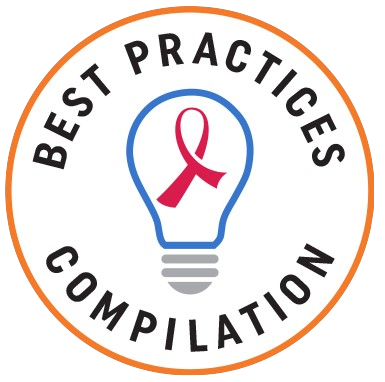TAVIE Red is a mobile application that aims to improve retention in HIV care and address social determinants of health. It helps case managers connect with clients and uses gamification, a technique with elements of gameplay such as earning points and completing quests, to increase engagement with HIV care and psychological self-care management tools. The Rhode Island Executive Office of Health and Human Services (RI EOHHS) and its Ryan White HIV/AIDS Program (RWHAP) Part B-funded providers implement TAVIE Red in partnership with 360 Medlink, a company that specializes in digital health technology. Clients can access TAVIE Red if they are 18 or older, eligible for RWHAP Part B, and have a new diagnosis of HIV, are not engaged in care, or are in care but not virally suppressed or at risk of falling out of care. TAVIE Red participants overwhelmingly reported that the technology helped them manage their HIV diagnosis.
RI
Increased engagement and retention in HIV care has been shown to promote viral suppression. However, it remains difficult for many people with HIV to adhere to care due to structural issues such as poverty, unstable housing, food insecurity, and lack of transportation.1 RI EOHHS has also found that direct service providers, such as clinicians and case managers, often indicate that they do not have enough time to spend with clients. TAVIE Red aims to address these gaps by providing participants with a free, accessible, and user-friendly digital tool that promotes communication, HIV care management, and access to social supports.
“[TAVIE] explains what you need to do. It tells you you’re not alone, don’t be afraid, this is what you need, this is not the end of your life . . . having [TAVIE] could really save somebody.”
TAVIE Red is a mobile application that promotes health by using gamification to maintain client engagement in care. Game features include quests, scenarios requiring problem solving, and token rewards for completion of quests.
TAVIE Red also helps participants manage their HIV care through treatment reminders, a CD4 and viral load charting tool, health-related self-assessments, and information regarding the location of nearby community resources.
TAVIE Red is used in conjunction with TAVIE Pro, a platform for case managers to communicate directly with participants. Through this portal, case managers can schedule appointments and send announcements and personalized messages. They can also monitor participant progress through the completion of self-assessments.
Case managers help participants connect to TAVIE Red by providing information on how to download, register, and use the application. They also give participants smartphones with unlimited talk, text, and voicemail features and host informational sessions, which include an overview of TAVIE Red features and explanation of how it can support viral suppression and address barriers to adherence. Participants must sign a consent form as part of the onboarding process.
TAVIE Red was evaluated with a diverse sample of 233 clients that used the application between November 2018 and December 2020, supported by the Center for Innovation and Engagement’s (CIE) Equity in Evaluation Project. Participants in the study found that TAVIE Red is an engaging intervention and overwhelmingly reported it assisted them with managing their HIV care. In addition, viral suppression rates increased by five percentage points from baseline.
| Category | Information |
|---|---|
| Evaluation data | Data were collected through the TAVIE Red application, participant self-assessments at baseline and every six weeks, and CAREWare, the data management system used by RI EOHHS RWHAP Part B-funded providers. |
| Measures |
|
| Results |
|
Source: NASTAD. TAVIE Red. [SPNS Equity in Evaluation Intervention Guide.] July 2022.
Stakeholder input. Surveys and focus groups allowed participants, case managers, and community organizations to provide feedback on which key features to include, as well as which were essential for designing the application. Older iterations of TAVIE Red helped orient these conversations. The RI Community Advisory Board piloted the application for further refinements.
Staffing. The TAVIE Red leadership team consists of RI EOHHS and 360 Medlink staff. Core staff also include 60 case managers, AIDS Drug Assistance Program (ADAP) coordinators, and supervisors at six provider locations funded by RWHAP Part B. ADAP coordinators and case managers support outreach and participant enrollment. Site coordinators, also located at each provider location, oversee case managers and day-to-day operations.
Training. All staff are trained on the application and case manager portal, so they can use the technologies themselves and provide technical support to clients. Trainings, offered in part through instructional videos, include how to replace lost phones and responses to frequently asked questions.
RI EOHHS used resources from a RWHAP Part B supplemental grant to support TAVIE Red. Smartphones and data plans are government-issued, reducing costs. The TAVIE Red team aims to secure additional funding to promote long-term sustainability by further analyzing and disseminating positive project outcomes.
- Continuously gathering and incorporating feedback from participants and case managers can ensure that the application meets user needs.
- While digital health technology can be an effective tool to increase health outcomes, distrust in technology and lack of technological literacy can dissuade participation. Training efforts should address basic technology use, like how to turn a smartphone on and off, and security measures to improve participant comfort level.
- Policies and systems are needed to track and replace lost or stolen smartphones.
- Participants with higher barriers to care, such as poor mental health and access to housing, had lower rates of TAVIE Red participation. Therefore, providers should address how digital platforms can better engage these clients.

